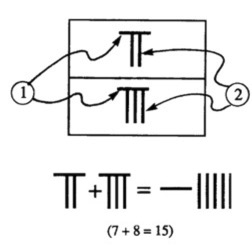- About MAA
- Membership
- MAA Publications
- Periodicals
- Blogs
- MAA Book Series
- MAA Press (an imprint of the AMS)
- MAA Notes
- MAA Reviews
- Mathematical Communication
- Information for Libraries
- Author Resources
- Advertise with MAA
- Meetings
- Competitions
- Programs
- Communities
- MAA Sections
- SIGMAA
- MAA Connect
- Students
- MAA Awards
- Awards Booklets
- Writing Awards
- Teaching Awards
- Service Awards
- Research Awards
- Lecture Awards
- Putnam Competition Individual and Team Winners
- D. E. Shaw Group AMC 8 Awards & Certificates
- Maryam Mirzakhani AMC 10 A Awards & Certificates
- Two Sigma AMC 10 B Awards & Certificates
- Jane Street AMC 12 A Awards & Certificates
- Akamai AMC 12 B Awards & Certificates
- High School Teachers
- News
You are here
Reflections on Chinese Numeration Systems: Some Basic Operations
Rod numeral algorithms for the basic arithmetical operations parallel those we employ today [Lam and Ang 2004]. The visual pattern presented by the rod numerals facilitates the performance of simple arithmetic operations. For example, consider how the addition of \(7 + 8\) was accomplished, as is illustrated in the diagram below. A trained computer would first note the strokes for the numeral \(5\), i.e., the horizontal strokes, ① combine them and carry one horizontal stroke into the next column. The remaining vertical strokes would then be added together ②. In performing this procedure, a rod was physically “carried” to the next column—the ancient Chinese used this term to describe the process of moving ahead one tens place on the left in their numeration scheme.

Figure 5. An example of the addition operation. Figure drawn by the author.
In the subtraction process, the Chinese used the term “borrow” to indicate the moving of a ten to the right to permit a subtraction. Thus, in principle, their algorithms for performing addition and subtraction were very similar to ours. Where subtraction eliminated a tens position, the rod protocol left an appropriate blank space in the corresponding cell on the computing surface. For example, \(107\) would be represented with rods on a board as:

Figure 6a. Evolving techniques for representing zero place value. Figure drawn by the author.
and then transcribed in the following manner:

Figure 6b. Evolving techniques for representing zero place value. Figure drawn by the author.
Knowledgeable mathematical scribes would be able to discern the number of empty position places in a numeral and interpret the designated number correctly. A written symbol, 0, was adopted as an empty placeholder for use by the Chinese in the 12th century CE. Thus, from that time onward, \(107\) would be recorded as:

Figure 6c. Evolving techniques for representing zero place value. Figure drawn by the author.
In the event that a numerical quantity became negative during the computational process, a supplementary rod was laid diagonally across the existing configuration. Another amazing fact concerning rod numerals is that from the 2nd century BCE onward they came in two colors, black and red, to represent negative and positive numbers respectively! What is the significance of these two colors in referring to a mathematical situation today? For tactile discrimination, positive rods had a triangular cross section and negative rods a square cross section. An examination of old Chinese arithmetic manuals reveals rules for working with negative numbers that are the same as those we use today. One such extant reference is Sun Zi suanjing, from ca 400 CE [Lam and Ang 2004]. The foundations for rod multiplication and division are based on the concepts of repeated addition and subtraction, respectively. Chinese multiplication and division algorithms also mirrored our own, depending on the use of partial sums and partial products. Rod procedures for these operations are rather too complex for consideration here; however, they are fully examined and discussed in sources such as [Straffin 1998] and [Swetz 1979].
Rod configurations allowed for the expression of both common and decimal fractions. Common fractions were expressed by two rod configurations: a numerator, referred to in Chinese as the “son,” and a denominator, the “mother”. A relationship of dependence was implied between the two mathematical entities. So, mother and son would comprise a fraction, one placed vertically above the other; for example, \(3/8\) would be represented as shown below.

Figure 7. A fraction in rod numerals. Figure drawn by the author.
This convention was adopted by Islamic merchants, brought back to their home countries, and utilized in commercial and business computations. Eventually, their computer-scribes placed a line between the two numerical indicators. This later version, the one we know today, was transmitted to Europe in 1202 by the Italian merchant, Leonardo of Pisa [Sigler 2002]. For the Chinese, decimal fractions were indicated within rod placement by their position on the computing surface. Numerical entries positioned in the cells to the right of the units position represented descending powers of a tenth.
Frank J. Swetz (The Pennsylvania State University), "Reflections on Chinese Numeration Systems: Some Basic Operations," Convergence (February 2022)




